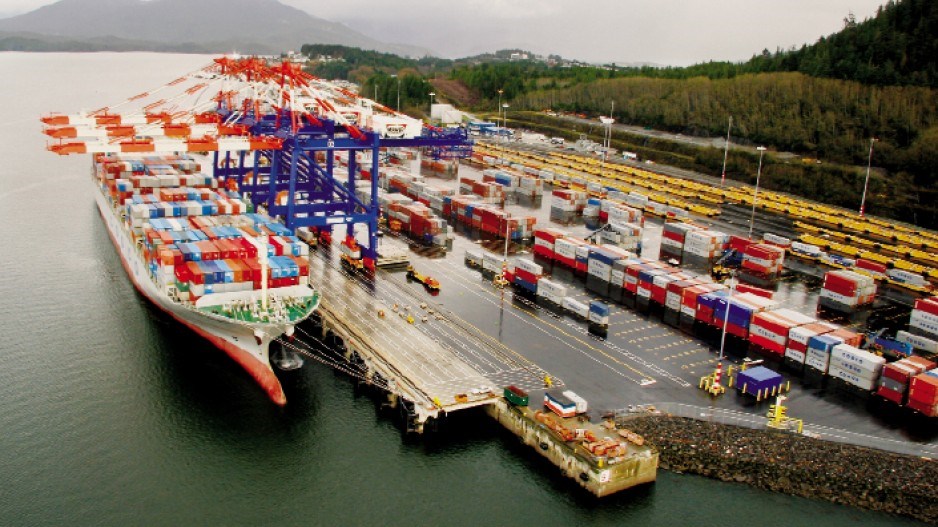The owner of two B.C. container shipping terminals is joining with one of North America’s largest pension fund managers to create a $5 billion funding pool to invest in global container terminals.
DP World, which owns Prince Rupert’s Fairview and Vancouver’s Centerm container terminals, is creating the fund in partnership with Caisse de dépôt et placement du Québec (CDPQ), Canada’s second largest pension fund manager.
Dubai-based DP World will hold a 55% share of the new investment pool; CDPQ will hold the remaining 45%.
The investment fund will be seeded with DP World’s two B.C. container terminals. According to the investment fund announcement, CDPQ will acquire a 45% stake of the combined terminal assets for $865 million.
The B.C. terminals deal is CDPQ’s second major port investment. In November 2013, it acquired a 26.7% stake in Australia’s Port of Brisbane, which handles approximately $50 billion in cargo per year. CDPQ has more than $40 billion in port, airport, energy, water treatment and other industrial infrastructure investments around the world.
Macky Tall, the company’s executive vice-president of infrastructure, said CDPQ chose the two B.C. ports for its initial investment in North American port terminal facilities because they are well located, well operated and “deliver very efficient service to customers.”
Last year, DP World announced a $200 million investment in the seven-year-old Fairview terminal to increase its container cargo-handling capacity by approximately 60%. In December, DP World said it would be conducting a feasibility study for Phase 2 of the terminal expansion that could increase its annual handling capacity to more than two million 20-foot containers from 850,000.
Maersk Line, the world’s largest container shipping carrier, plans this week to add another transpacific service to Prince Rupert and Vancouver, to meet growing customer demand and what Maersk Canada president Jack Mahoney said are the cost competitive options to reach Canadian and American markets that the two Canadian ports provide.
DP World acquired Fairview from Deutsche Bank (NYSE:DB) in April 2015 for $580 million.
The number of container shipping lines offering service to Prince Rupert, one of North America’s fastest growing container shipping ports, has increased to 10 from one when it opened for container service in 2007.
DP World also plans to invest $350 million in expanding its Centerm container terminal on the south shore of Vancouver’s inner harbour.
In a recent update to its 2012 Study of U.S. Inland Containerized Cargo Moving through Canadian and Mexican Seaports, the U.S. Federal Maritime Commission (FMC) raised concerns over the continued migration of North American container shipping traffic away from U.S. West Coast ports north to Canadian and south to Mexican ports.
Atop the list of reasons for that migration: West Coast port congestion and the lingering effects of work stoppages and cargo-handling interruptions at American ports during the eight months of contract negotiations between the International Longshore and Warehouse Union and the Pacific Maritime Association that took place from mid-2014 through early 2015.
In his letter accompanying the update, FMC Commissioner Richard Lidinsky stated that 2015 was “a pivotal year for U.S. cargo diversion into Canada and Mexico.”
The Port of Vancouver is also planning to increase its containerized goods handling capacity with its proposed $2 billion Terminal 2 expansion.
However, the global container shipping industry, weighed down with huge over capacity and record low rates for containerized cargo, has been under significant pressure.
Drewry, a U.K.-based shipping consultancy, reported earlier this year that sales in 2016’s first half were down 18% for major global carriers and that the industry has lost more than US$50 billion in sales since 2014. In late 2015, the company cut 2016’s projected growth to 3.3% from its previous estimate of 4.9%.
More recently, Drewry estimated 2016’s global growth rate on major container shipping routes could be the third lowest this century if the second half of the year follows the trend in the first six months.
Hanjin Shipping Co. Ltd.’s filing for receivership August 31 further underscored the container shipping sector’s financial challenges.
But Vancouver Fraser Port Authority president and CEO Robin Silvester noted in a recent Business in Vancouver story that the container shipping industry and ports are two distinct businesses. “Ports,” he said, “is a better place to be.”
According to the press release announcing the DP World- CDPQ investment fund, DP Group Chairman and CEO World Sultan Ahmed Bin Sulayem echoed that sentiment.
“The opportunity landscape in the port and terminal sector remains significant,” he said, “and this partnership offers us greater flexibility to capitalize on these opportunities while maintaining a strong balance sheet and retaining control.”
He added that the partial monetization of DP World’s Canadian assets “further strengthens our balance sheet.”
CDPQ president Michael Sabia added that the deal with DP World will give his company “unique access to high-quality transactions, and the opportunity to invest in the best port infrastructure worldwide.”
DP World has 77 marine and inland terminals in 40 countries.
As at June 30, CDPQ held $255 billion in net assets.




